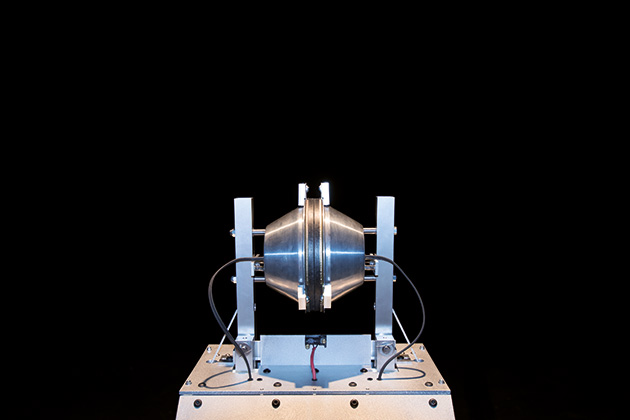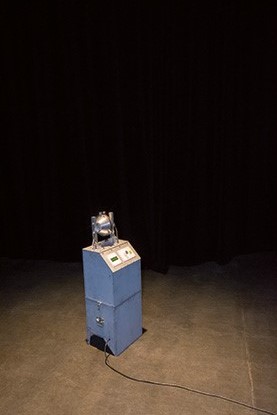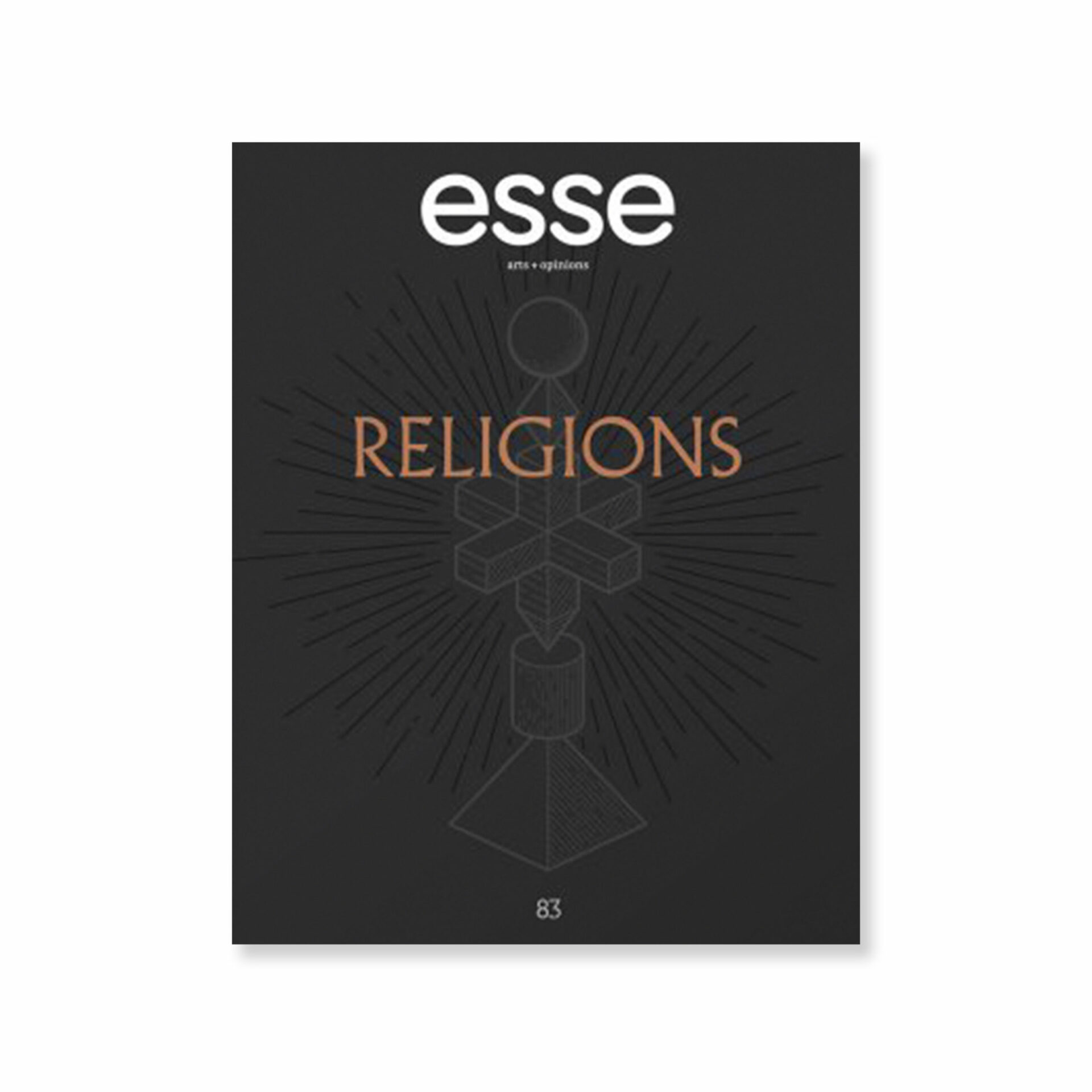
[En anglais]
The large room of the Agora Hydro-Québec du Cœur des sciences de l’UQAM is dark, any semblance of natural light vanquished by the long heavy black curtains that wrap around the insides of the cavernous space. Opening the door feels as though one has stepped from the overly lit mundanity of everyday life into the hallucinatory DIY dystopia of a Shane Carruth film set.1 1 - Shane Carruth is the director of the celebrated 2004 science-fiction film Primer and 2013’s Upstream Color. Half-recognizable sounds and images providing just enough sensory balance for the listener/viewer to experience the transferral from signal back to noise.2 2 - The sonic narrative of Upstream Color is strongly influenced by Michel Serres’ The Parasite (Baltimore: John Hopkins University Press, 1982), which partly concerns the implication of unavoidable noise within any communicative act between two or more parties. Extending the parasitic metaphor, it feels as though the building we stand in — an academic architecture dedicated to the phenomenological pursuits of science — has been infected by the sonic fiction of Saucier & Heys’ new robotic installation Radiabolus.
As our eyes slowly adjust to the shadowy logic of the scientifically fictive environment — appropriately situated in this vaguely dissonant outpost of Montréal’s second edition of the International Digital Arts Biennial entitled PHYSICAL/ITÉ3 3 - The Biennial (BIAN), which occurred between May 1 and June 19, 2014 included the work of over forty-nine artists across thirty-one venues in Montréal. More information can be found at http://bianmontreal.ca (accessed October 4, 2014). — it is the ears that start trying to make sense of the vocalized numbers being reflected around the room. They are not enveloping us though, as is the norm when frequencies are sent spilling from stereo speakers. With the visual coordinates of the work simultaneously anchored and scrambled by the robotic objects outlying the centralized temporary architecture, the audible mapping that occurs is also initially confusing given that the voice is beamed in straight Euclidean lines, a delineation of space that we more regularly associate with the gaze. Ultimately though, as in Saucier & Heys’ other large-scale installations produced over the past decade4 4 - Saucier and Heys (previously known as The KIT Collaboration and Robert Saucier) are most readily identified with their two major sound installation projects, Infrasense and Virutorium, both of which developed narratives around the convergence of embodied and technological viruses. For more information, see the joint catalogue Infrasense/Virutorium: Viral Projects by The KIT Collaboration and Robert Saucier (Manchester: Thirdsound Press, 2010). For online documentation of Infrasense and Virutorium see https://eavm.uqam.ca/saucier-robert.html http://www.art.mmu.ac.uk/profile/theys/gallery it is the disembodied utterance that will entice and disorient, and in the process chronicle a distorted history.


Radiabolus, detail, 2014.
Photos : courtesy of the artist
Approaching the installation’s kinetic aluminium speaker units, it becomes clearer that the sound is being literally shone by a Hypersonic Sound System speaker. It surveys and cuts up the spatiality of the Agora from a pole protruding from the glowing cotton transarchitecture (created from a military parachute that has been repurposed into a makeshift laboratory. Along with the crates that help hold it up, the suggestion is that all the elements pack up into a mobile system that can be airdropped). Rather than bleeding out into the surrounding space, the sound from the HSS is highly directional because it is intertwined with ultrasonic frequencies and only becomes audible when it exposes itself upon a material object, such as a wall, a floor, a head. This is a new way of thinking about and experiencing sound.5 5 - For more information on HSS speakers see www.atcsd.com/pdf/HSSdatasheet.pdf (accessed October 5, 2014)
Courtesy of a technique known as heterodyning that allows sound to be directed straight into the skull of an intended target, it is Philip K. Dick’s nightmare finally realized in the form of a consumable technology.6 6 - The science-fiction writer Philip K. Dick had an ongoing interest/obsession with the idea that governments and other species of being had the capacity to control the human mind via remote technologies. For further reading, see Charles Platt, “The Voices in Philip K. Dick’s Head” in the New York Times, 2011. www.nytimes.com/2011/12/18/books/review/the-exegesis-of-philip-k-dick-edited-by-pamela-jackson-jonathan-lethem-and-erik-davis-book-review.html? pagewanted=all&_r=0 (accessed October 4, 2014) In contrast to the off-the-shelf variety of paranoiac delivery systems, the five speaker units that extend out around it are distinctly futuristic albeit within an antiquated aesthetic. They look as though a 1950s meteorological team might have joined forces with a Ghost Army7 7 - The “Ghost Army” was a tactical deception unit within the U.S. military that consisted of approximately 1,100 actors, sound technicians, artists, designers, and other “creative types” taken from art schools and advertising agencies to compose and construct deceptive soundscapes, radio transmissions, rubber tanks, and camouflage. squad to carry out a range of spectral experiments in a post-apocalyptic soundscape. Out of the functional aluminium trunks of the units stand two speakers, which are clamped together, so much so that the sound being played through them is virtually muted. That said, if standing close enough, one can discern a set of faint melodic and percussive whispers as if we are tuning into a radio station from the other side of sentience.

Radiabolus, detail, 2014.
Photo : courtesy of the artist
So that the listener/viewer can hear what kind of music is being played on these military-style jukeboxes, one must input a set of the vocalized numbers that are being pointed around the space by the HSS speaker. Referencing the clandestine lists of morse/numerical codes read out on shortwave numbers stations8 8 - Numbers stations, which started operating just after WW2 are generally accepted as being operated by Governments around the world in order to send secret information to spies, although no politician or military source has ever owned up to being responsible for one. A comprehensive research project named the Conet Project: Recordings of Shortwave Numbers Stations was released on Irdial Discs in 1997 and can be found at www.irdial.com/conet.htm (accessed October 4, 2014) the cyphers can be entered via an invitingly heavy analogue knob that twists and clicks each time one enters a digit; the tight twists of the wrist back and forth mimicking the delicate choreography of a safecracker. Upon the final turn of the dial the speakers slowly open up like a desert plant receiving rain for the first time in months, broadcasting the concealed seeds of its sonic cargo in the process.
Drum & Bass, country, ambient, rock, death metal, gamelan, something resembling a gnarled J-pop, 9 9 - A style of Japanese Pop Music that became mainstream in Japan in the 1990s. and schmaltzy rom-com ballads make up the seemingly postmodern DJ set from the abode of the damned. This is in fact a sampling of the content from the five speaker units, each of which plays ten tracks dating back to the 1950s, that takes in a global sample of twenty-three countries in the process. Each track that plays, upon the parting of the speakers, has been stripped bare of its spoken word elements so that it is just the music left, the instrumental seduction of military recruiting adverts that aim to (predominantly) lure those approaching (or in early) adulthood into state-sanctioned military organizations.
This is world music with a whole other meaning and functionality, a global mix of differentiated sirens, each one used to lure the televisual traveller into a new life of martial coordination. A world in which the military-entertainment complex expertly mixes the sonic stuff of civilian life with the clarion call of the conflict zone. That there is such a diversity in the style and genre of the tracks is a testament to the reconnaissance undertaken by those who fully comprehend the notion that the ideation and attraction of violence can be rendered most effectively when it is composed with a culturally germane soundtrack that has the capacity to ignite and temper emotions on command.
Forged in the blue(s) heat of musical mythology, the legend of Robert Johnson is instructive here, telling as it does of a Faustian pact made with the devil that would allow the singer to achieve his ambitions of commercial success in return for signing over the rights to his life’s soundtrack, along with his soul, to the bank of hell.10 10 - Further cultural analysis can be found in Andrew Bretz’s text “Me and the Devil Blues: Robert Johnson and the Faust Legend.” This can be located at www.academia.edu/447826/Me_and_the_Devil_Blues_Robert_Johnson_and_the_Faust_Legend (accessed October 7, 2014) It is this very myth that embodies the metaphysical relations that many cultures believe at some level, that music, and those who produce it, have a “special relationship” with the afterworld. Radiabolus, meanwhile, its name suggestive of a radio station from perdition that transmits a single “diabolus in musica”11 11 - Within the musical lexicon, a tritone is an interval that spans three whole tones. Through its musical dissonance and alleged provocation of sexual feelings in the listener, the tritone earned the name of “Diabolus in Musica” or “The Devil in Music” around the turn of the early eighteenth century (as documented in F. J. Smith “Some aspects of the tritone and the semitritone in the Speculum Musicae: the non-emergence of the diabolus in music,” Journal of Musicological Research, 3 (1979): 63-74). channel, seems more aptly located at the crossroads of purgatory, connecting as it does, the realms of the living with the international zones of the (possibly) soon to be dead.
